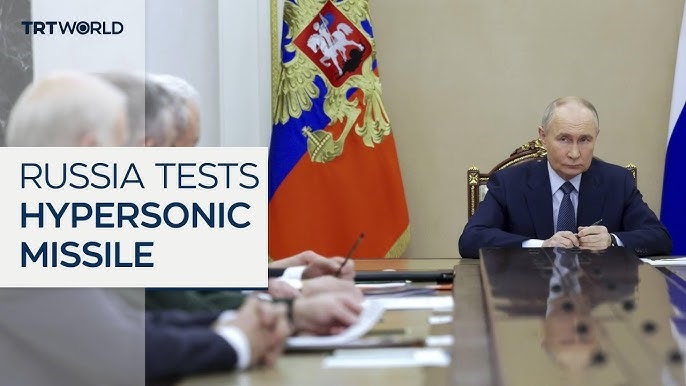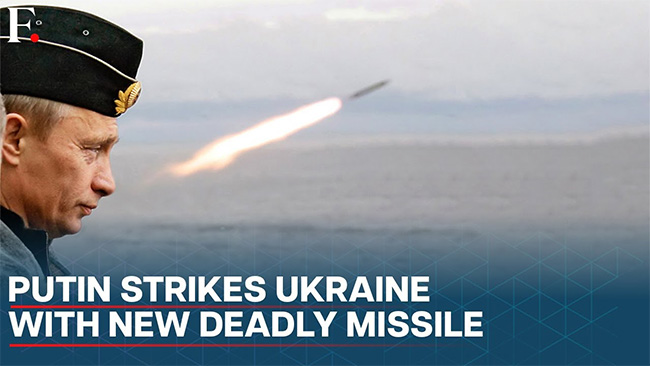
Another weapon in Russia's arsenal. Vladimir Putin claimed responsibility on Thursday, November 21, for the firing of a "new medium-range missile" against a Ukrainian arms factory, reports France TV Info.
A model previously unknown, described as "experimental", but which he asked on Friday to launch "mass production". This test is presented by Moscow as a response to Ukraine's firing of long-range Western missiles against Russian territory, which the United States has just authorized. While some of its characteristics and its exact range remain unclear, this new model could carry several nuclear warheads and not just one.
On Friday, Vladimir Putin ordered "to begin serial production" of the new missile and said the Russian military would continue testing it, during a televised meeting with military officials. He said Russia had a "stockpile" of the missiles, "ready to use," and that "no one else in the world" currently had this type of weaponry.
Unlike other Russian projectiles already used against Ukraine, such as the Iskander and the Kh-101, which can only carry a single nuclear warhead, this latest missile would be capable of carrying multiple warheads, Tom Karako, director of the missile defense project at the Center for Strategic and International Studies in Washington, told The New York Times. A feature that would make these warheads almost impossible to intercept, explains the American daily.
Ukrainian intelligence, quoted by AFP, estimates that the missile fired Thursday "was equipped with six warheads, each equipped with six submunitions", based on a video posted on social networks showing six powerful successive flashes falling from the sky at the time of the attack.
According to Vladimir Putin, the Orechnik missile fired Thursday can reach the speed of Mach 10, ten times the speed of sound, "or 2.5 to 3 kilometers per second" (around 12,350 km/h). "There is no way to counter such weapons today", he estimated. According to Ukrainian intelligence, it even reached "on the final part of the trajectory" a speed "higher than 11 Mach" (around 13,600 km/h).
Contrary to initial claims by the Ukrainian Air Force that Russia had fired a long-range intercontinental ballistic missile, the Pentagon called the projectile an "intermediate-range ballistic missile," as did Vladimir Putin.
This launch is part of a period of tensions since November 17, when the United States authorized Ukraine to use long-range missiles against Russian territory. The Ukrainian military has already launched American ATACMS and British Storm Shadow missiles at targets in Russia.
Moscow had promised an "appropriate response." In his televised address on Thursday, Vladimir Putin presented the launch of the Oreshnik as a response to two Ukrainian launches. "The regional conflict in Ukraine, previously provoked by the West, has acquired global characteristics," he said, saying he did not rule out striking countries whose weapons Ukraine uses in Russia.
Putin also announced that Russia was working on developing short- and medium-range nuclear missiles to counter American plans to produce and deploy similar missiles in Europe and Asia. "I believe that the United States made a mistake by unilaterally breaking the treaty on the elimination of intermediate- and short-range missiles in 2019, under a far-fetched pretext," he said. The United States withdrew from the agreement in 2019, under Donald Trump's first term.

On Friday, at a meeting in the Kremlin with the military top brass, Putin revisited the topic where he clarified that Oreshnik not really at an “experimental” stage, as Pentagon had determined, but its serial production has actually commenced, writes M.K. Bhadrakumar, Indian Ambassador and prominent international observer.
And he added, “Given the particular strength of this weapon, its power, it will be put into service with the Strategic Missile Forces.” He then went on to reveal, “It is also important that along with the Oreshnik system, several similar systems are currently being tested in Russia. Based on the test results, these weapons will also go into production. In other words, we have a whole line of medium- and shorter-range systems.”
Putin reflected on the geopolitical backdrop: “The current military and political situation in the world is largely determined by the results of competition in the creation of new technologies, new weapons systems and economic development.”
Succinctly put, the escalatory move authorised by the US president Joe Biden has boomeranged. Did Biden bite more than he could chew? This is the first thing.
The US apparently decided that Putin’s “red lines” and Russia’s nuclear deterrence were the stuff of rhetoric. Washington was clueless about the existence of a wonder weapon like the Oreshnik in the Russian armoury that is as demonic frightening as a nuclear missile in its sheer destructive apocalyptic potential but will spare human lives. Putin added calmly that Russia intends to give advance notice to civilians to get out of the way before Oreshnik heads for its designated target to annihilate it. The shock and awe in the western capitals speaks for itself. Biden avoided commenting on the issue when asked by reporters.
The Oreshnik is not an upgrade of old Soviet-era systems but “relies entirely on contemporary cutting-edge innovations,” Putin stressed. Izvestia reported that Oreshnik is a new generation of Russian intermediate-range missiles with a range of 2,500-3,000km and potentially extending to 5,000km, but not intercontinental, equipped with multiple independently targeted re-entry vehicles (MIRV) — i.e., having separating warheads with individual guidance units. It has a speed between Mach 10 and Mach 11 (exceeding 12,000 kms per hour).
In his statement on Thursday, Putin said, “there are no means of countering such weapons today. Missiles attack targets at a speed of Mach 10, which is 2.5 to 3 kilometres per second. Air defence systems currently available in the world and missile defence systems being created by the Americans in Europe cannot intercept such missiles. It is impossible.”
Indeed, a terribly beauty is born. For, Oreshnik is not just an effective hypersonic weapon and is neither a strategic weapon nor an intercontinental ballistic missile. But its striking power is such that when used en masse and in combination with other long-range precision systems, its effect and power is on par with strategic weapons. Yet, it is not a weapon of mass destruction — rather, it’s a high-precision weapon.
Serial production implies that dozens of Oreshnik are in the process of being deployed, which means that no US/NATO staff group and no Anglo-American target intelligence unit in bunkers in Kiev or Lvov is safe any longer.
Oreshnik is also a signal to the incoming US president Donald Trump who is ad nauseam calling for an immediate end-of-war settlement. Oreshnik, ironically, has been developed only as Moscow’s reaction to the hawkish decision by then US president Trump in 2019 to unilaterally withdraw from the 1987 Soviet-American treaty on intermediate range nuclear forces (INF).
Make no mistake, Russia is under no illusions. Putin will not waver from the conditions he outlined in June for resolving the conflict: the withdrawal of Ukrainian troops from Donbass and Novorossiya; Kiev’s commitment to abstain from joining NATO; the lifting of all Western sanctions against Russia; and the establishment of a non-aligned, nuclear-free Ukraine.
Clearly, this war will continue on its course till it reaches its only logical conclusion, which is Russian victory. Russian Security Council Deputy Chairman Dmitry Medvedev is spot on when he said in an interview with Al Arabiya yesterday that the use of Oreshnik missile “changes the course” of the Ukrainian conflict.
The Western capitals will have to reconcile with the reality that the scope for escalation of the war is ending. Make no mistake, if another ATAMCS strike inside Russia is attempted, it will have devastating consequences for the West.
Serbian President Aleksandar Vucic put it nicely: “If you [NATO] think you can attack everything on Russian territory with Western logistics and weapons without getting a response, and that Putin won’t use whatever weapons he deems necessary, then you either don’t know him or you’re abnormal,” notes M.K. Bhadrakumar.
read more in our Telegram-channel https://t.me/The_International_Affairs

 12:11 26.11.2024 •
12:11 26.11.2024 •






















